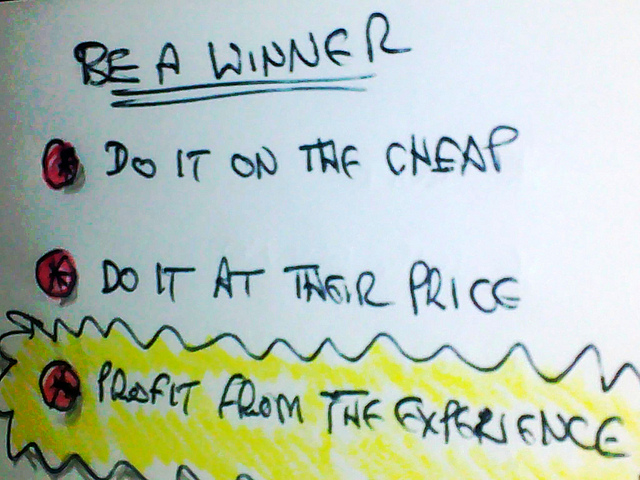
The odds of your startup being around three years from now are not good.
Statics show that about nine of every ten new businesses fail that quickly. Often it isn’t from a lack of hard work or even a great idea. The real downfall is a lack of discipline where it counts. Too often basics – knowing your market, having enough cash, establishing a healthy corporate culture – are dumped into the hope and pray bucket.
This is the folly of failure. A marketing strategist I know likes to put the concept in mathematical format:
P(s) = 1 – P(f)
This reads that the probability of success equals one minus the probability of failure. The smaller you make the right side of the equation, the more you reduce the probability of failure, the more likely you are to succeed. CarMax (and their now deceased parent Circuit City) were built on this concept. Both these retailers analyzed what people hated about buying used cars and household appliances, and removed these barriers from their operations. They reduced the probability of failing to sell their products.
Most startups fail by failing to do a few Tough Things First.
Legs
Your product or business idea must have legs. It must have enough broad market appeal to last longer than the third year. Why? Markets change, and all products eventually lose favor. While your first product is hot, you need to be designing your next product. But if your second invention isn’t ready before your market changes, your cash flow will fall and take your R&D budget with it.
Market knowledge
Knowledge is power and markets make you money. So not knowing your market as well as it can be known is unprofitable. Since R&D, marketing, and sales are expensive, every extra bit of market knowledge reduces the amount of money you waste in these activities.
Plan your defense
Your business plan is both offense – marching into market territory, attacking competitors – and defense. Most startups only look to offense. You must defend your ground against business cycles, market changes, inevitable law suits, and more. One factor in reducing the probability of failure is to watch for attackers and prepare your defenses.
Be confident
The better you prepare, the more confident you can be, and confidence is key to leadership. Nobody follows a cowardly general into battle, and employees will not strive to succeed when the CEO lacks courage. Your preparation will also lead to better business practices and a wisely run outfit, which emboldens employees.
Get help
Even the largest corporations recruit experts. You need mentors to help make smart choices for where your expertise has limits. Never be afraid to ask for help – most mentors are generous with their time and their guidance. They can save you from mistakes both minor and critical.
Do whatever it takes
Tenacity and optimism are closely linked. Both lead to the constant, energetic striving that underlies successful businesses. You will encounter speed bumps and roadblocks, but you must persevere and overcome them. Many businesses fail because the founders simply quit when they could have punched through.
The reason why Micrel, the semiconductor company I founded and led for 37 profitable years (36 on a GAAP basis), thrived in the horrendously cyclic chip business is that we did the Tough Things First (and that is why Tough Things First is the title of my book covering the management and leadership that went into Micrel). Doing things that seem hard or boring is exactly what builds the foundation that so many businesses fail to lay.
Be the one in ten that does the Tough Things First.
Image via Creative Commons Licence and Julian Partridge
